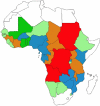Human African trypanosomiasis: pharmacological re-engagement with a neglected disease
- PMID: 17618313
- PMCID: PMC2441931
- DOI: 10.1038/sj.bjp.0707354
Human African trypanosomiasis: pharmacological re-engagement with a neglected disease
Abstract
This review discusses the challenges of chemotherapy for human African trypanosomiasis (HAT). The few drugs registered for use against the disease are unsatisfactory for a number of reasons. HAT has two stages. In stage 1 the parasites proliferate in the haemolymphatic system. In stage 2 they invade the central nervous system and brain provoking progressive neurological dysfunction leading to symptoms that include the disrupted sleep wake patterns that give HAT its more common name of sleeping sickness. Targeting drugs to the central nervous system offers many challenges. However, it is the cost of drug development for diseases like HAT, that afflict exclusively people of the world's poorest populations, that has been the principal barrier to new drug development and has led to them becoming neglected. Here we review drugs currently registered for HAT, and also discuss the few compounds progressing through clinical trials. Finally we report on new initiatives that might allow progress to be made in developing new and satisfactory drugs for this terrible disease.
Figures





References
-
- Allsopp R. Options for vector control against trypanosomiasis in Africa. Trends Parasitol. 2001;17:15–19. - PubMed
-
- Anonymous Human African trypanosomiasis (sleeping sickness): epidemiological update. Wkly Epidemiol Rec. 2006;81:71–80. - PubMed
-
- Ansede JH, Anbazhagan M, Brun R, Easterbrook JD, Hall JE, Boykin DW. O-alkoxyamidine prodrugs of furamidine: in vitro transport and microsomal metabolism as indicators of in vivo efficacy in a mouse model of Trypanosoma brucei rhodesiense infection. J Med Chem. 2004;47:4335–4338. - PubMed
-
- Ansede JH, Voyksner RD, Ismail MA, Boykin DW, Tidwell RR, Hall JE. In vitro metabolism of an orally active O-methyl amidoxime prodrug for the treatment of CNS trypanosomiasis. Xenobiotica. 2005;35:211–226. - PubMed
-
- Apted FIC.Treatment of human trypanosomiasis (Chapter 36) The African Trypanosomiases 1970Allen & Unwin Ltd: London; 684–710.In: Mulligan HW (ed).
Publication types
MeSH terms
Substances
LinkOut - more resources
Full Text Sources
Other Literature Sources

